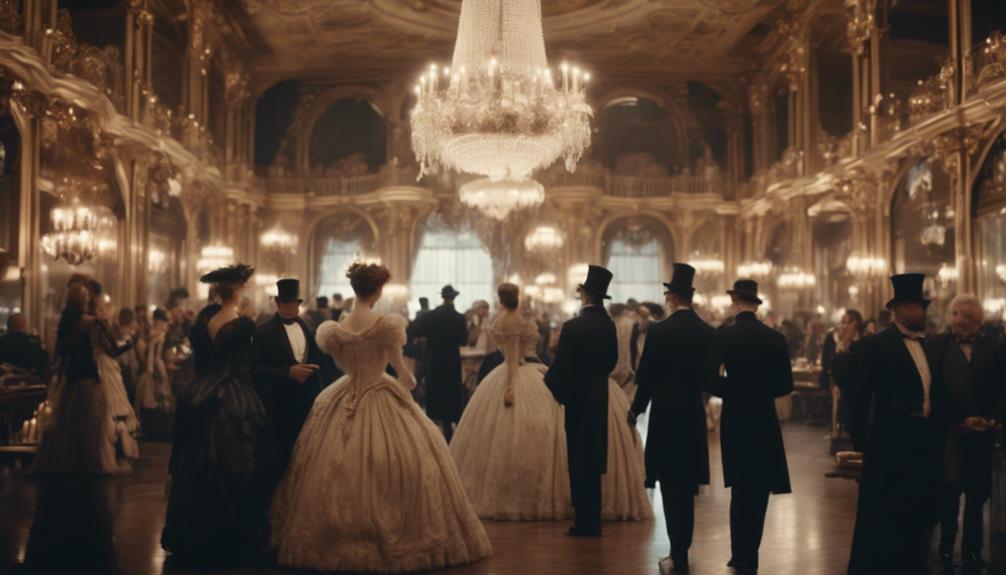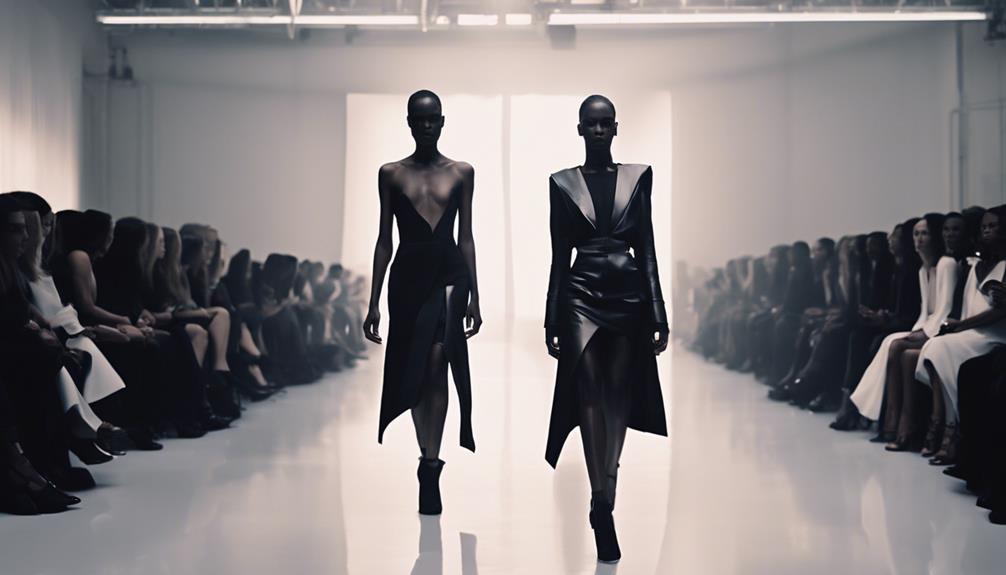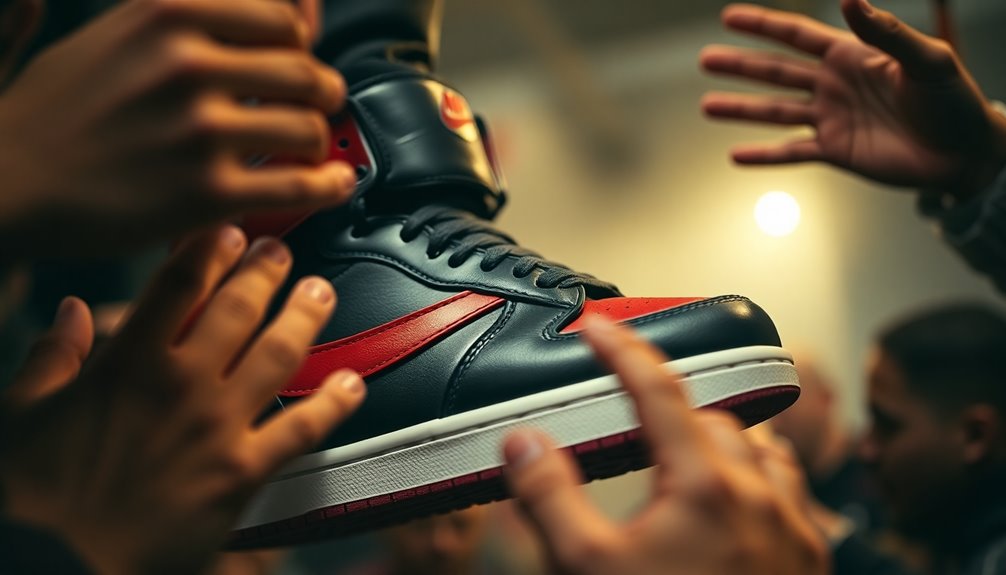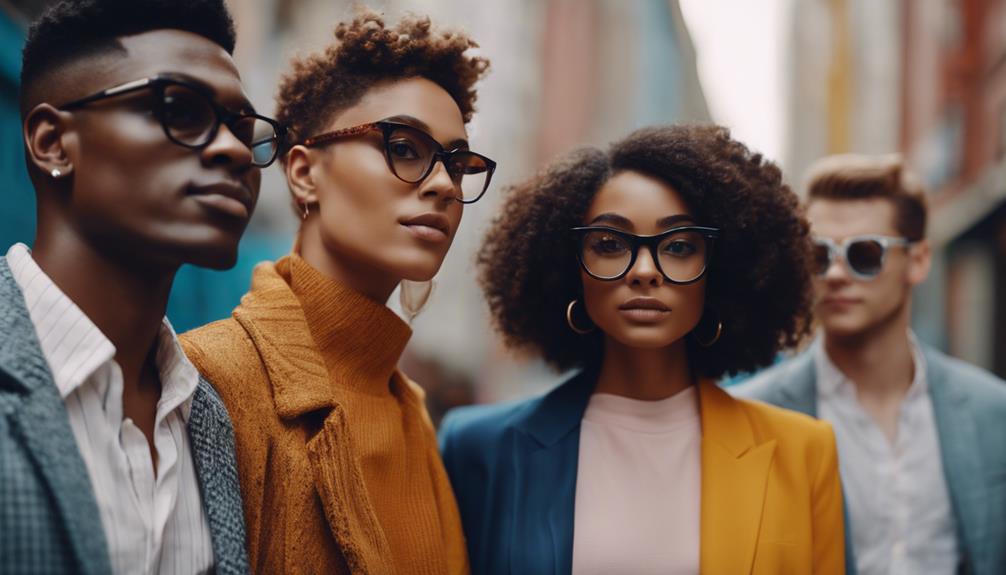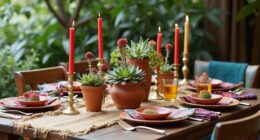The fashion of the 1890s signifies a notable transition from the ornate Victorian styles to more expressive designs. You will find luxurious fabrics like velvet and satin, paired with intricate embroidery that exudes both sophistication and social standing. High-neck blouses and voluminous skirts highlight modesty while still allowing for personal expression. This period also paved the way for modern interpretations, combining historical aesthetics with current trends. To embrace this style, accessorize with lace gloves and bold statement hats. Exploring how these classic styles impact today’s fashion can spark creativity and influence your wardrobe choices in new and exciting ways.
Key Takeaways
- The 1890s fashion featured rich fabrics like velvet and satin, showcasing luxury and elegance in formal attire.
- Corsets and voluminous skirts defined the silhouette, emphasizing modesty while reflecting societal status.
- Modern designers reinterpret Victorian aesthetics, blending historical elegance with contemporary styles for a fresh appeal.
- Statement accessories like lace gloves and ornate hats enhance outfits, capturing the opulence of the era.
Origin and historical background of the fashion trend/style
You might wonder how the fashion of the 1890s emerged from the earlier Victorian styles.
Queen Victoria's reign set the stage for a transformation in fashion, emphasizing both opulence and societal norms.
As the Industrial Revolution took hold, new materials and methods changed how people dressed, paving the way for the unique styles of the 1890s.
Fashion's Transformation Through Decades
Fashion's transformation through decades reflects a dynamic interplay of cultural shifts, technological advancements, and evolving social norms, shaping styles from the Victorian era to the early 20th century.
During the Victorian era, from 1837 to 1901, Victorian fashion epitomized elegance with its elaborate garments, corsets, and voluminous skirts, all emphasizing modesty and societal status. The Industrial Revolution played a pivotal role, as it enabled the mass production of textiles, making fashion more accessible. This shift not only introduced ready-to-wear clothing but also transformed shopping habits, democratizing style for a broader audience.
Prominent designers like Charles Frederick Worth set the stage for haute couture by showcasing collections on live models, influencing future fashion houses. As the late Victorian period progressed, movements like the Rational Dress Society emerged, advocating for more practical clothing and hinting at shifting ideals around women's rights.
This paved the way for the more liberated Edwardian fashions that followed, especially with innovators like Paul Poiret. These changes marked the beginning of a significant evolution in women's clothing, reflecting a move towards timeless fashion that balances both comfort and style.
Queen Victoria's Fashion Reign
Queen Victoria's fashion reign, marked by opulence and strict social norms, greatly shaped the styles of the 19th century, reflecting the era's values and aspirations.
During the Victorian Era, fashion became a symbol of identity and status, with elaborate garments emphasizing modesty and refinement. The introduction of synthetic dyes, like mauveine, democratized color, allowing a broader range of vibrant hues that appealed to various social classes, though wealthier women often preferred delicate pastels.
Corsets emerged as a defining element of women's fashion, creating a silhouette that both highlighted and constrained femininity within a patriarchal society. This period also saw the rise of influential designers, such as Charles Frederick Worth, who pioneered haute couture and transformed the fashion industry with his innovative presentations.
Fashion magazines played a vital role too, making styles more accessible and shaping public trends. They spread the allure of timeless elegance, influencing people across different social strata.
Queen Victoria's reign not only established a fashion legacy but also reflected the complex interplay of societal expectations, artistic innovation, and the evolving landscape of 19th-century life.
Key Characteristics
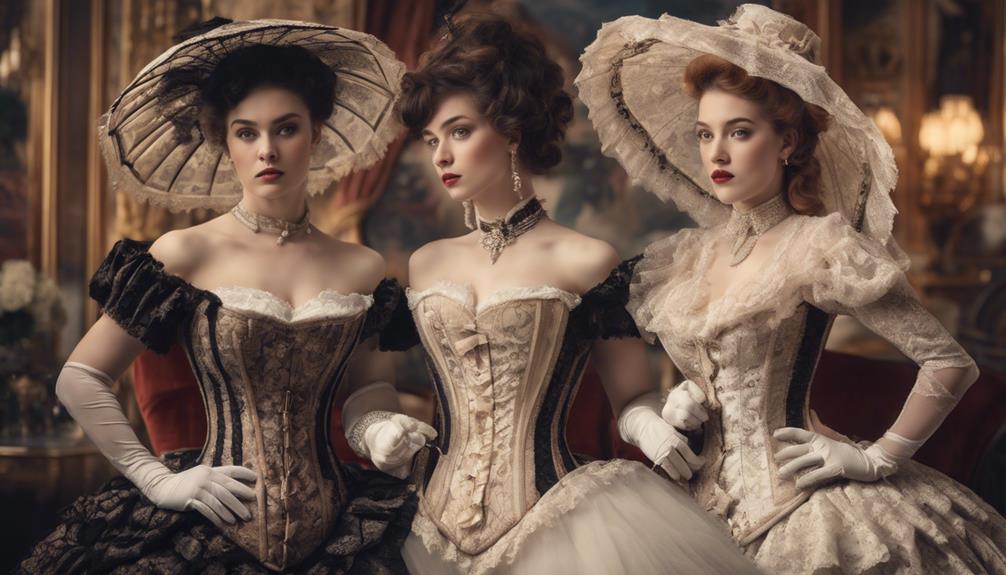
When you think about 1890s fashion, you'll notice key characteristics that stand out.
Elaborate embroidery and rich fabrics like velvet and satin create a sense of luxury, while lace-collared blouses add an intricate touch to women's wardrobes.
This blend of textures and details truly defines the elegance of the era.
Elaborate Embroidery and Patterns
In the 1890s, elaborate embroidery and intricate patterns became essential elements of Victorian fashion, showcasing craftsmanship and reflecting social status.
You'll notice that the attention to detail in these designs was extraordinary. Popular techniques included whitework, where white thread created texture on matching fabrics, and silk thread embroidery, known for its vibrant colors and sheen. These styles weren't just decorative; they were status symbols. Wealthy women often sported garments adorned with elaborate designs to highlight their social standing.
Fabrics like silk, velvet, and lace were frequently enhanced with embroidery, adding to the opulence of their outfits. The intricate floral and geometric patterns revealed the era's emphasis on craftsmanship, capturing the eye with their complexity.
Even with the introduction of mass production in the late Victorian period, which allowed for more accessible embroidered patterns, the essence of these elaborate designs remained. You could find women of various social classes incorporating these decorative elements into their wardrobes, proving that the allure of exquisite embroidery transcended class boundaries.
In this way, the rich tapestry of Victorian fashion truly celebrated both artistry and individuality.
Rich Velvet and Satin Fabrics
Embracing rich velvet and satin fabrics, Victorian fashion showcased a luxurious texture and an opulent appearance that defined evening gowns and formal attire. These materials weren't just about aesthetics; they symbolized social status and wealth.
Rich velvet, known for its softness and depth of color, was often crafted from silk or cotton. You'd find gowns in striking shades like royal blue, deep green, and burgundy, each hue embodying elegance.
Satin, with its glossy surface and matte back, added a delicate touch to women's garments. It enhanced the overall elegance of outfits, making it a popular choice for formal occasions. The interplay between these fabrics created a visual richness that captivated onlookers.
Thanks to advances in textile production during the Industrial Revolution, rich velvet and satin became more accessible to a broader range of society. While they remained favorites among the upper class, middle-class women began incorporating these luxurious fabrics into their wardrobes.
This shift allowed more people to experience the glamour associated with velvet and satin, forever changing the landscape of Victorian fashion. You can see how these materials continue to inspire modern designs today.
Elaborate Lace-Collared Blouses
Elaborate lace-collared blouses stand out in Victorian fashion for their high necklines and intricate lace detailing that highlight both modesty and elegance. These blouses often feature ruffled collars and cuffs that add a romantic flair, making them perfect for both everyday wear and formal occasions.
You'll find that they're typically made from lightweight fabrics like cotton or silk, ensuring comfort while maintaining a structured silhouette. Victorian-inspired pieces like these blouses frequently pair well with corsets, accentuating the coveted hourglass figure of the era.
The delicate lace not only enhances the beauty of the blouse but also serves as a nod to the craftsmanship of the time. As you explore modern interpretations, you'll notice that the popularity of lace-collared blouses has resurged, blending vintage charm with contemporary styles.
Today, whether you're dressing up for a special event or seeking a unique addition to your wardrobe, these blouses remain a versatile choice. Their timeless appeal continues to captivate fashion enthusiasts, proving that elegance can indeed stand the test of time.
Modern Interpretation
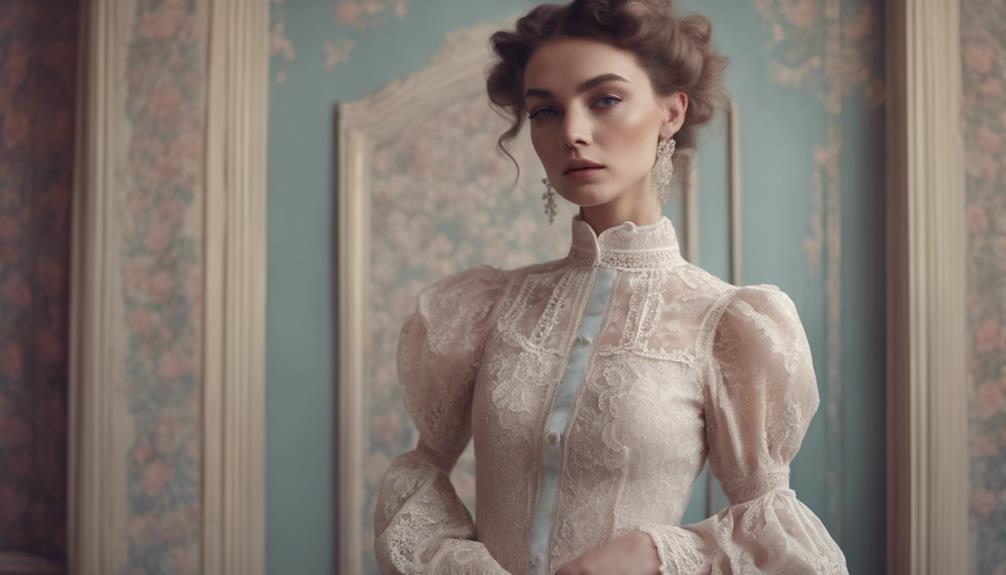
You'll notice how modern fashion has revived Victorian silhouettes, blending them with today's styles for a fresh take.
Renowned labels are drawing inspiration from this era, creating pieces that resonate with fashion icons both past and present.
As you explore these interpretations, you'll see how they celebrate the elegance of the 1890s while making it relevant for contemporary wardrobes.
Revival of Victorian Silhouettes
The revival of Victorian silhouettes in modern fashion celebrates the feminine form through contemporary designs that transform traditional corsets into symbols of empowerment and self-expression.
You'll find that today's designers embrace the elegance of the Victorian era while reinterpreting its elements for a new audience. Corsets, once restrictive, now accentuate your curves and provide a sense of confidence.
As you explore this trend, notice the voluminous skirts that echo the grandeur of crinolines and bustles, adding drama and movement to your wardrobe. High necklines, featuring ruffled collars and mock necks, offer a sophisticated touch to everyday outfits, making them feel more elevated.
Lace plays a pivotal role in this revival of Victorian silhouettes, bringing romance and intricate details to blouses and dresses. You can easily incorporate this timeless fabric into your own style.
To complete your look, don't forget about accessories like statement jewelry, lace gloves, and ornate hats—each piece allows for personal flair and creativity. By embracing these Victorian-inspired elements, you not only pay homage to the past but also redefine what it means to express your individuality in modern fashion.
Renowned Victorian-Inspired Fashion Labels
Victorian-inspired fashion labels like Vivienne Westwood and Alexander McQueen seamlessly blend historical aesthetics with contemporary design, making them a go-to for those who appreciate the elegance of the past.
These designers skillfully incorporate Victorian elements such as corsets, high collars, and lace into their modern collections, creating a striking fusion of vintage charm and current trends.
Rachael O'Neill stands out for her bespoke Victorian-inspired garments, celebrating intricate craftsmanship and romantic silhouettes that attract both vintage enthusiasts and contemporary fashion lovers.
The Gothic Shop specializes in pieces that feature lace, velvet, and corsetry, catering to alternative fashion trends while drawing on historic influences.
Dollydagger embraces a vintage-inspired look, combining vibrant colors and playful designs that resonate with modern audiences.
Meanwhile, Bettie Page Clothing channels classic styles from the Victorian and Edwardian eras, offering dresses and accessories that emphasize feminine silhouettes and vintage allure, making them a favorite among retro fashion fans.
These renowned labels showcase how Victorian elements can be reimagined within contemporary fashion, allowing you to express your style while honoring the timeless elegance of the past.
Fashion Icons of the Era
Drawing inspiration from the past, modern fashion icons have reinterpreted Victorian aesthetics, making them relevant and appealing in today's style landscape. Designers like Alexander McQueen and Dolce & Gabbana often infuse their collections with elements reminiscent of the Victorian era, such as high necklines, lavish fabrics, and intricate lacework. By doing so, they pay homage to the fashion icons of the past, including Queen Victoria, who popularized trends that still resonate today.
Additionally, the elaborate designs of the Edwardian era, characterized by shirtwaist blouses and elaborate hats, are reimagined in contemporary wardrobes, blending vintage aesthetics with modern sensibilities. Influential figures like Paul Poiret, who liberated women from restrictive corsets, laid the groundwork for styles that prioritize comfort and individuality.
Today, you'll find modern interpretations of voluminous skirts and corsets that celebrate both historical richness and current fashion trends. As you explore these styles, remember that the legacy of Victorian fashion icons continues to inspire your wardrobe choices, providing a unique fusion of elegance and modern flair that stands the test of time.
Styling Tips
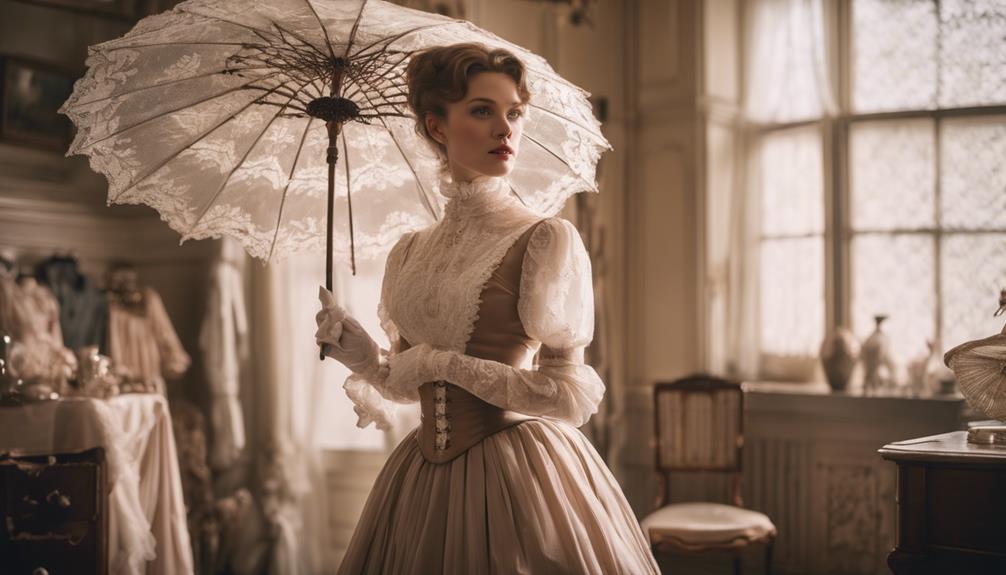
When you're styling your outfits, think about incorporating Victorian-inspired statement accessories to elevate your look.
Layering textures and fabrics not only adds depth but also pays tribute to the layered ensembles of the 1890s.
With these tips, you can create a chic and elegant look that merges modern flair with historical charm.
Victorian-Inspired Statement Accessories
Incorporating lace gloves into your outfit adds a touch of Victorian elegance, showcasing refinement and social status. These delicate accessories were essential in the Victorian era, and they instantly elevate any ensemble you choose.
Pair your gloves with a statement hat adorned with ribbons, feathers, or flowers to capture the intricate styling of Victorian headwear. This combination not only enhances your look but also pays homage to a time when hats completed both casual and formal outfits.
Don't forget to include ornate fans in your accessories. They're functional and serve as a nod to flirtation from the Victorian period, adding sophistication and historical charm.
Additionally, opt for cameo brooches or elaborate jewelry pieces that reflect the opulence of the era. These items not only showcase wealth and status but also act as conversation starters.
Lastly, consider incorporating a parasol with decorative details into your outfit. It's a playful yet stylish element that offers sun protection while maintaining that Victorian aesthetic.
With these statement accessories, you'll embody the elegance and grandeur of the Victorian era in your modern wardrobe.
Victorian-Inspired Layered Ensembles
A Victorian-inspired layered ensemble combines high-neck blouses, corsets, and voluminous skirts to create a sophisticated silhouette that captures the era's elegance.
To embrace this style, start with a high-neck blouse, opting for delicate lace details that reflect Victorian fashion's romantic essence. Pair it with a corset to cinch your waist, enhancing your feminine silhouette.
Next, choose a tiered A-line skirt that offers dramatic movement and exudes grandeur. This silhouette not only nods to the Victorian era but also allows for a modern twist. Ruffled collars or mock necklines are excellent choices to frame your face beautifully and elevate the overall look.
Don't forget to accessorize! Statement jewelry, lace gloves, and stylish hats are essential for completing your Victorian-inspired ensemble. These accessories add layers of personal style and echo the social status importance of the era.
Layering Textures and Fabrics
To achieve a truly enchanting Victorian-inspired look, layering different textures and fabrics is key to creating depth and richness in your outfits. Start by combining luxurious materials like lace, silk, and velvet. For instance, pair a delicate lace blouse with a structured velvet skirt to enhance visual interest while capturing the essence of Victorian elegance.
Don't forget about volume! Incorporating petticoats or crinolines under your skirts can add movement and a nod to the voluminous silhouettes of the Victorian era, even when using lighter materials. This approach allows you to maintain a modern twist while celebrating historical style.
Mixing high-neck blouses with tailored jackets or coats can further emphasize that timeless silhouette, blending femininity and structure beautifully.
Accessorizing is essential, too. Opt for textured items like a lace-trimmed shawl or embellished gloves to complete your layered outfits. These intricate details not only elevate your look but also reflect the importance of craftsmanship in Victorian fashion.
Shopping Guide
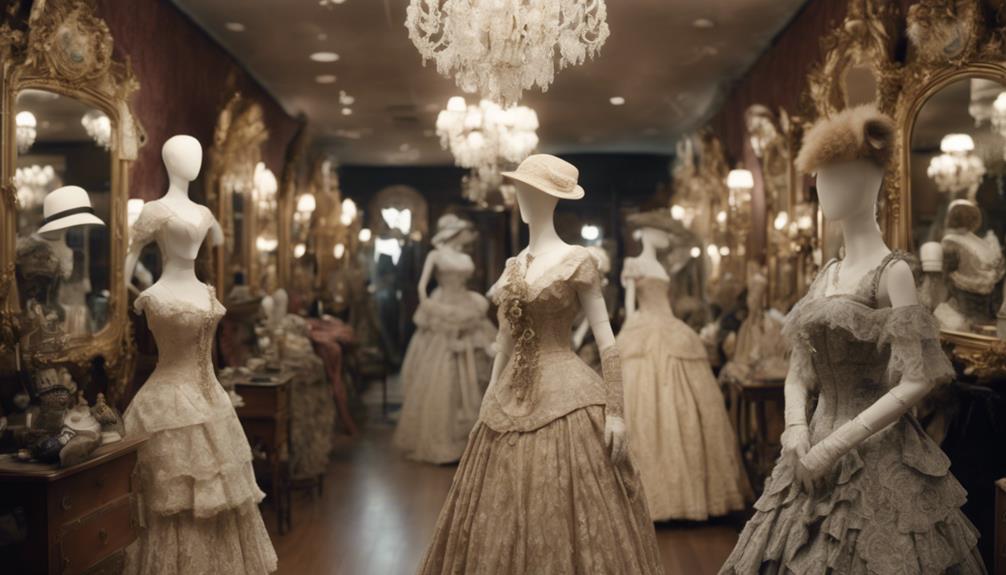
Explore vintage markets and online platforms to discover unique Victorian-inspired clothing and accessories that capture the essence of 1890s fashion. You'll find everything from intricately designed lace blouses to voluminous skirts, perfect for channeling that timeless elegance.
Don't overlook fashion retailers offering modern interpretations of Victorian styles; they often incorporate contemporary fabrics and designs, making them easier to wear in today's world.
If you're keen on a personalized touch, consider custom tailoring services that create bespoke Victorian garments tailored just for you. This guarantees a perfect fit while showcasing your individual flair.
Additionally, attending themed events or historical reenactments can be a fun way to rent or purchase authentic Victorian costumes, allowing you to fully immerse yourself in the era's fashion.
For inspiration, utilize fashion blogs and social media platforms that highlight how to blend Victorian elements into your modern wardrobe. They can provide valuable tips on mixing and matching styles, guaranteeing you look chic while honoring the past.
With these resources at your fingertips, you're well on your way to curating a stunning Victorian-inspired collection!
Victorian-Inspired Upcycling Projects
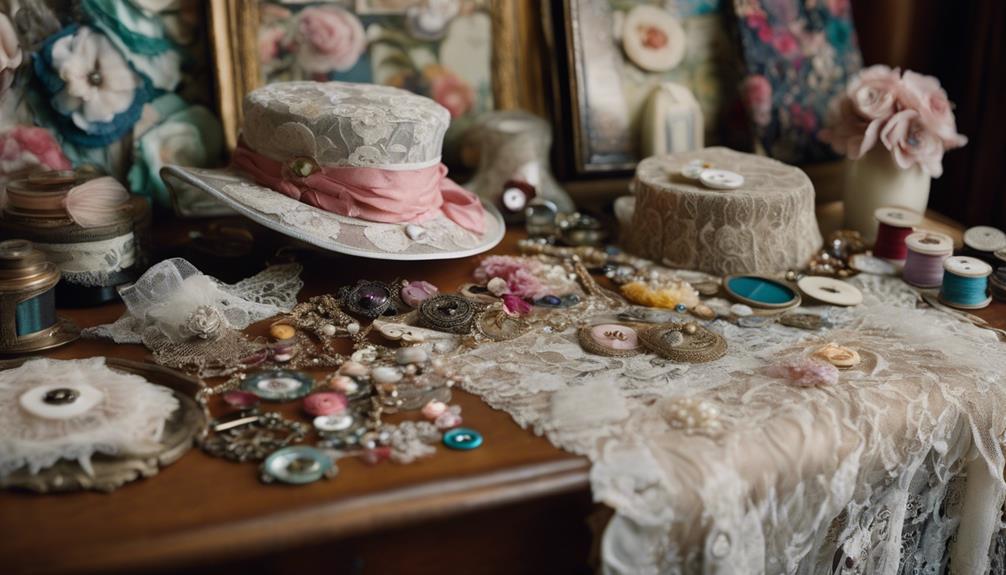
If you love Victorian fashion, upcycling with fabric remnants can be a rewarding way to express your creativity.
You can repurpose vintage fabrics into chic accessories or unique garments that highlight those classic details.
Let's explore some projects that can breathe new life into your wardrobe while keeping that timeless Victorian charm.
Victorian Fabric Remnants Projects
Victorian fabric remnants offer a treasure trove of possibilities for crafting unique accessories and home decor that blend historical charm with modern style. You can easily transform lace, silk, and velvet remnants into stunning hairpieces, stylish bags, or elegant jewelry that reflect timeless fashion trends while minimizing waste.
Consider upcycling old garments, too. For instance, turning a voluminous skirt into a chic dress or repurposing a corset into a fashionable top allows you to infuse new life into outdated pieces. You can also create beautiful throw pillows or wall art, incorporating Victorian elegance into your contemporary living spaces.
Crafting patchwork quilts from various Victorian fabric remnants not only showcases intricate designs but also tells a story of craftsmanship from that era. Engaging in these projects promotes sustainability in fashion, encouraging a mindful approach to clothing consumption and a deeper appreciation for historical textiles.
Repurposing Vintage Fabrics
Repurposing vintage fabrics opens up a world of creative possibilities, allowing you to craft modern garments infused with the elegance and charm of the past. By using materials from the Victorian era, like silk, lace, and velvet, you can create unique pieces that showcase their timeless appeal. For instance, consider transforming an old lace tablecloth into an elegant blouse or dress, capturing that romantic aesthetic.
You can also reimagine vintage corsets as statement pieces, blending historical and contemporary style effortlessly. By incorporating these elements into your wardrobe, you not only celebrate the artistry of Victorian textiles but also promote sustainability in fashion. Using remnants from old garments, such as embroidered details or trims, can further enhance your modern creations, adding a touch of history and craftsmanship.
These upcycling projects allow you to express your creativity while preserving the beauty of the past. So, gather those vintage fabrics and start experimenting! Whether you're making a chic skirt or a delicate top, each piece becomes a conversation starter, reflecting your unique style and appreciation for timeless fashion.
Cultural Impact
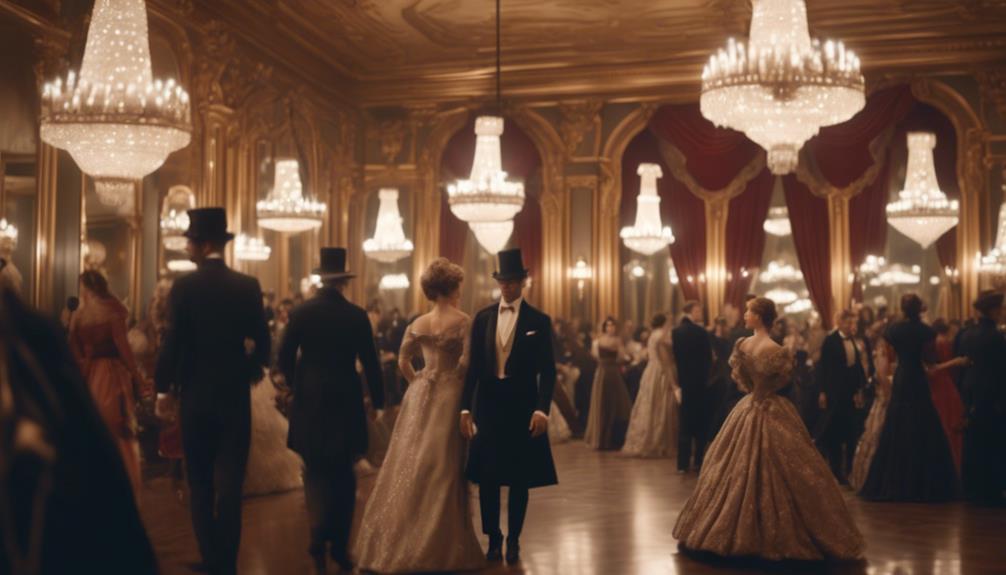
As you explore the cultural impact of 1890s fashion, you'll notice how it laid the groundwork for steampunk aesthetics and women's suffrage movements.
These influences shaped not only clothing styles but also social attitudes around identity and empowerment.
Understanding these connections reveals the broader significance of fashion beyond mere fabric and thread.
Steampunk Fashion Influence
Steampunk fashion blends historical elegance with imaginative innovation, creating a cultural impact that resonates across diverse artistic expressions. This unique style fuses Victorian-era aesthetics with futuristic, steam-powered technology, resulting in timeless looks featuring corsets, top hats, goggles, and gears.
You can see how this subculture emerged in the late 20th century, inspired by the works of authors like H.G. Wells and Jules Verne. Their romanticized vision of the Industrial Revolution laid the groundwork for a fashion movement that celebrates creativity and individuality.
As you explore steampunk, you'll notice its DIY ethos encourages you to craft customized garments, allowing you to express your personality while honoring Victorian styles. It's not just about the clothes; steampunk's influence stretches into art, literature, and gaming, merging historical elements with speculative fiction.
Steampunk conventions and themed festivals have popped up, fostering communities that appreciate this distinctive fashion and the imaginative narratives it embodies. Each event offers a chance for you to connect with fellow enthusiasts, showcasing the enduring charm of steampunk's blend of nostalgia and futurism, making it a truly enchanting cultural phenomenon.
Women's Suffrage Fashion Trends
The evolution of fashion during the late Victorian era not only embraced individual expression, as seen in steampunk, but also paved the way for women's suffrage, reflecting a growing desire for practicality and empowerment in clothing choices.
Women's attire began to shift towards more practical designs, moving away from the restrictive corsets and heavy skirts that once defined elegance. This change symbolized the suffragettes' fight for rights and autonomy.
Activists wore white, purple, and green to represent purity, dignity, and hope, respectively, turning these colors into a powerful visual statement.
The Rational Dress Society, founded in 1881, played a vital role in this transformation, advocating for clothing that allowed women greater mobility and comfort. Suffragettes skillfully used fashion as a political tool, donning sashes and badges with slogans during marches, amplifying their message and gaining visibility for their cause.
This cultural shift towards more egalitarian ideals not only influenced women's attire but also contributed greatly to the broader fight for women's rights, demonstrating that fashion could be both elegant and a means of empowerment.
Frequently Asked Questions
What Styles Were Popular in the Victorian Era?
In the Victorian era, you'd see corsets and voluminous skirts for women, while men wore tailored suits and top hats. Lace and silk dominated fabrics, reflecting sophistication and social status in every outfit.
What Is the Difference Between Edwardian and Victorian Fashion?
The main difference between Edwardian and Victorian fashion is in silhouette and style. While Victorian clothing emphasizes structure and opulence, Edwardian fashion embraces softer lines and elegance, reflecting a shift towards more relaxed and expressive designs.
What Was the Main Focus of Most Victorian Era Fashions?
The main focus of most Victorian era fashions is modesty and propriety. You'll notice women wore high-necked blouses and voluminous skirts, emphasizing a refined silhouette while corsets shaped their figures into an hourglass form.
What Did Victorian Era Dresses Look Like?
Victorian era dresses featured voluminous skirts, high necklines, and full sleeves, creating an exaggerated hourglass silhouette. You'd see intricate fabrics like silk and lace, complemented by corsets and elegant accessories that emphasized femininity and modesty.
What are the Timeless Styles from the Victorian Era that are still relevant for a classic look?
The Victorian era was known for its opulent old money fashion styles classic look that are still relevant today. Timeless pieces like high-neck blouses, ruffled sleeves, and tailored waistcoats continue to make a statement in modern wardrobes. The Victorian aesthetic exudes a sense of sophistication and elegance that never goes out of style.
Conclusion
Incorporating 1890s Victorian-inspired fashion into your wardrobe can add a timeless elegance to your style.
By understanding its origins and key characteristics, you can modernize these classic looks with confidence.
Whether you're exploring thrift stores for unique pieces or getting creative with upcycling projects, you'll find endless ways to express your individuality.
Embrace the charm of the past while making it your own, and you'll surely turn heads with your stunning, vintage-inspired outfits!
